“Upupa, ilare uccello calunniato
dai poeti, che roti la tua cresta
sopra l’aereo stollo del pollaio
e come un finto gallo giri al vento;
nunzio primaverile, upupa, come
per te il tempo s’arresta,
non muore più il Febbraio,
come tutto di fuori si protende
al muover del tuo capo,
aligero folletto, e tu lo ignori”
Eugenio Montale – “Ossi di Seppia”
(“Hoopoe, hilarious slandered bird
from poets, who rotate your crest
above the high pole of the hen house
and like a fake rooster you turn in the wind;
spring messenger, hoopoe,
thanks to you, time stands still,
February no longer dies,
how everything extends outside
when your head moves,
winged goblin, and you ignore it”)
In many areas of Italy it is called the “March cockerel”; the name derives perfectly well from two of its main characteristics: “cockerel” because it has a mobile and highly visible crest; “March” because it arrives here just in March, being a migratory bird. One of the “summer visitors”, that is, one of those species that come to us to nest, raise their offspring in good weather and then return to the warm African shores, south of the Sahara desert. The official Italian name of Hoopoe (Upupa epops), as well as that of the genus to which it belongs, is onomatopoeic referring to the verse emitted at the time of hatching and considered a dismal harbinger of doom or, on the contrary, a good omen. Certainly clearly identifiable and audible in the quiet of a coppice or a hilly olive grove, to match that of the cuckoo in the announcement of spring.
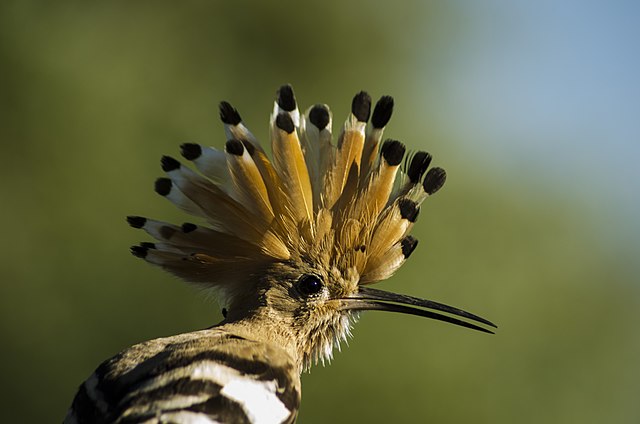
Photo by Thomas Figure CC Public Domain
Its colors are of extreme sobriety and elegance, with the wings and the long tail wrapped in white and black, the head, the neck and the body of a soft pink cinnamon, the same for both sexes. The erectile crest is characteristic, consisting of pairs of tapered feathers that it carries folded back, to unfold it forward in moments of alarm, territorial excitement, in courtship and almost as if it were a reflex of balance, even when it lands. Equally characteristic is the long slightly curved beak, not massive but well suited to rummage in the ground or under the bark in search of food. Worms, insects and their larvae, snails, and more rarely lizards and shrews, not disdaining some small nests of passerines.
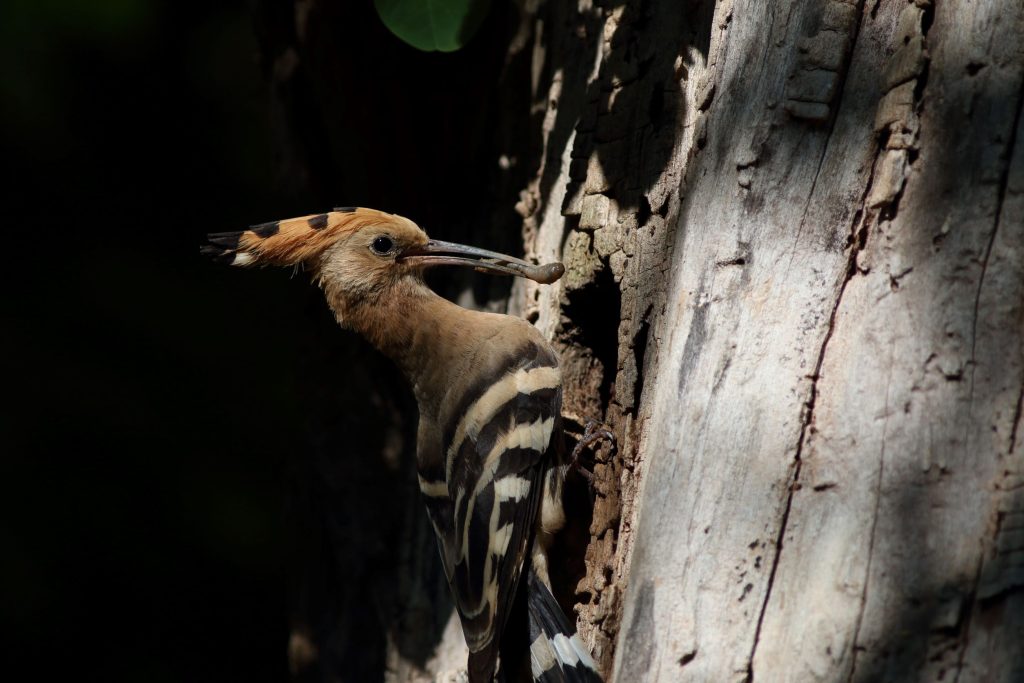
Photo by Aldo Sanmartin
It has relatively wide wings and an arched profile, which moves in a slow and almost at times listless way, so much so that it remembers the flight of butterflies. But he is certainly not naïve, knowing how to move quickly when threatened by a peregrine falcon from which he slyly escapes by taking refuge in the thicket of bushes. When it happened that they fell into our nets in Sardinia they were very funny, sticking to us with open wings just the way they got entangled, still without making any other movement to free themselves. It almost seemed as if they were waiting for us to get them out of trouble and fly back to a nest, where a hungry brood was certainly waiting for them. It was in fact May, the time of love.
Their wedding parades are really curious to see, with the males who, on the ground or on the branches, rise up stiffly arching their necks backward, unfolding their wings and tail and completely exhibiting their crest almost touching their beak. It is then that their rhythmic verse is most easily heard as it is made up of a sequence of short trisyllabic emissions, often translated with a pu-pu-pu or even with a bu-bu-bu. From this derives the name of “bubbola”, with which it is known in the Florentine or the Sienese name of “puppola”.

Photo by Aldo Sanmartin
The nesting takes place in holes in trees or in rock crevices and is in some ways exceptional as the nest is defined on the texts as having an “intolerable stench”. Indeed it is, and it is due to the fact that the feces of the chicks are not removed by the parents and fermenting together with food scraps transform it into a small dunghill. In addition, the hatching female and young emit a fetid exudate from a gland placed above the insertion of the tail (gland of the uropygium). In nature, hardly anything happens by chance without an adaptive twist, so such a stench is interpreted as an anti-predatory strategy, like what happens in certain mammals such as skunks.
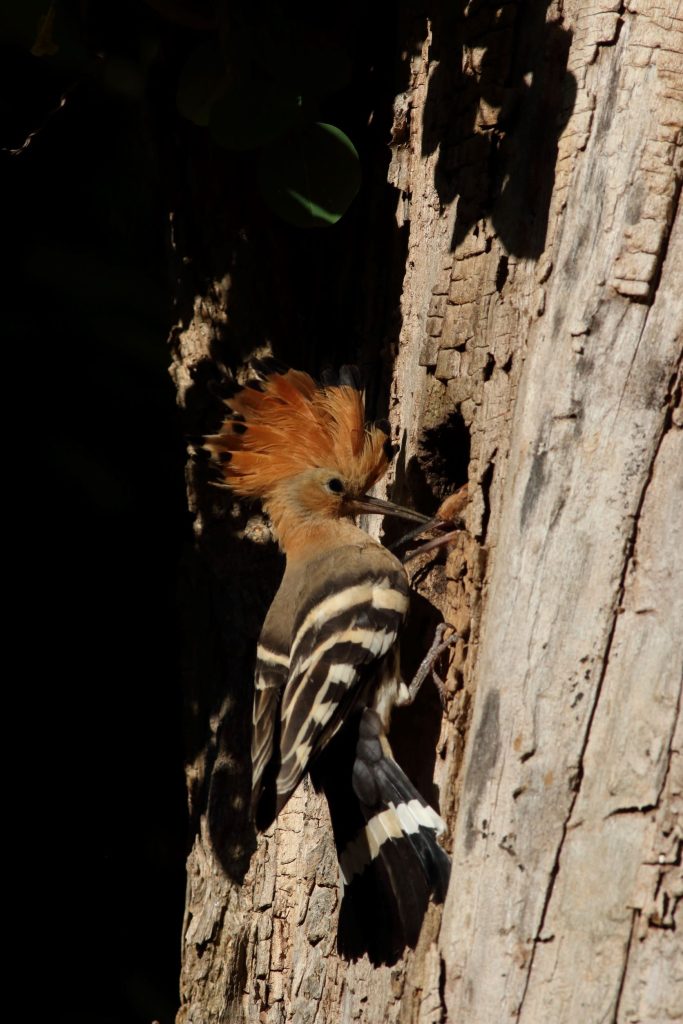
Photo by Aldo Sanmartin
The hatching is the exclusive task of the female, who remains in the nest for about fifteen days; it is therefore up to the male to provide for her partner by bringing her food. On the other hand, the care of the little ones is a shared task. The number of eggs laid is high and if the average is five, it can reach 12. The family bond is quite lasting even after the hatching of the young and often episodes of common foraging of the families are noted. A certain philopatry has been noted, so much so that the same nest can be used for several consecutive seasons by the same individual; this is certainly not surprising considering that a tree hole is certainly not available everywhere, thus representing a precious resource.
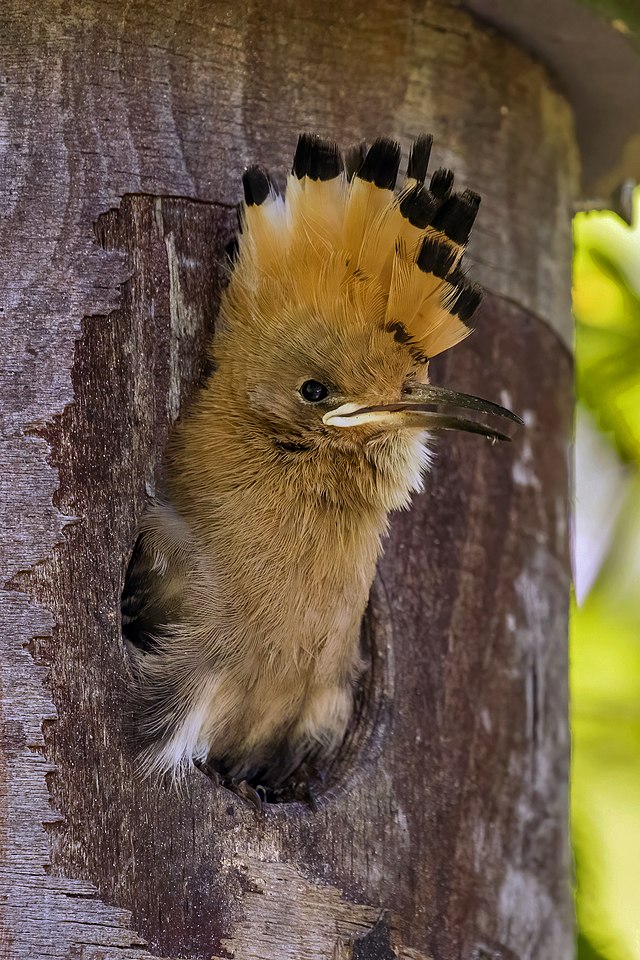
Photo by Charles J. Sharp CC- Public domain
Hoopoes as a species originated in tropical African areas, like bee-eaters, sea magpies and kingfishers, all species that started as migratory and then extended their range of presence to the north, reaching Europe; however, they are lacking in the northernmost parts of it.
It is worth remembering the place that the Hoopoe has had in the traditions, beliefs, symbolism and culture of different peoples starting with the Egyptians, where we often find it depicted in burials. In the initiatory texts it is associated with the figure of Solomon who used it as a messenger and confidant. It not only carried the king’s orders to his subjects but it was revealed the secrets of eternity by him. The signs of this status were evidenced by its crown of feathers and even more by an ornament that he wore on his chest, an indicator of its knowledge of the invisible world (perhaps in reference to a pink note of color that adorns its chest?). Solomon was a wise man and had transmitted his vast knowledge to his winged favorite, symbolizing the wisdom of the same Hoopoe which was transmitted with humility and modesty as befits the custodians of the divine mysteries!
In the Persian tale “The Word of the Birds” by Farid-ud-Din’Attar, the birds come together to elect their king. The hoopoe, aware of holding the secrets of creation, presided over the assembly and revealed to them that they already have a king. His name was Simurg and resided in a distant and inaccessible place, and so the hoopoe proposed to go and visit him. After a tremendous and perilous journey, the survivors arrived and there the hoopoe underwent a metamorphosis, turning into Simurg himself.
The Athenian playwright Aristophanes, the greatest representative of ancient Attic comedy, took up the myth of Tereus, king of Thrace and son of the god Ares, who is transformed by the gods into Hoopoe, and chose this as the protagonist of the comedy “The birds”, in which it was a leader of the people, and said: “Come here immediately here, who like me has wings; / you who feed on rural farms / those who nibble in the mountains / wild olive berries and strawberry trees / come on, all in flight at my call! “.
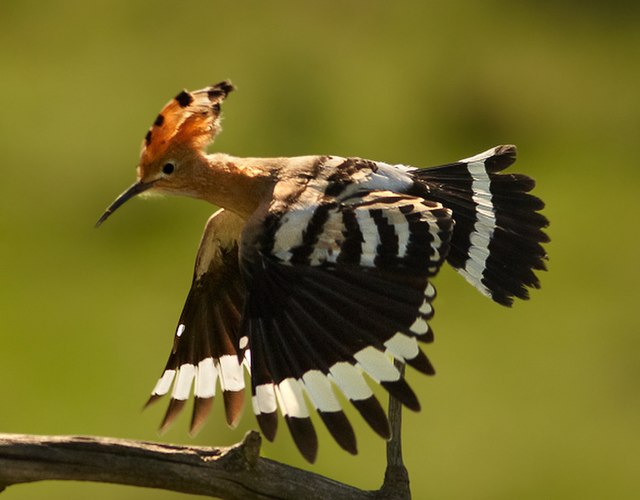
Photo by Martin Mecnarowsk CC Public domain
This myth of a wise bird, a connoisseur of the innermost secrets of human being, is however lost in the darkness of the Christian Middle Ages. There he was considered by the Fathers of the Church a despicable eater of garbage and opposed to the grace of the bird of paradise. The beliefs of San Cirillo and San Gerolamo were taken up and handed down in the illustrations of the bestiaries of the time, calling it an unclean, infernal bird, capable of making itself invisible. An unspecified grass which it used to make the nest, had the power to mask its presence and anyone who took possession of it could have made himself invisible! A magical power that served well to upset souls.
The final blow to the reputation of the Hoopoe was then given by Foscolo with his Sepulchres, poems that many of us have had to painstakingly memorize since middle school. He made it come out of a skull “where the moon flees”, flutter on the crosses of the “funereal countryside”, emitting “the filthy one a mournful sob”.
Penso tuttavia che le negative iperboli foscoliane siano solo il frutto di un errore e che l’Autore si riferisse in effetti al comportamento ed ai richiami del notturno allocco, che ben si addicono alle descrizioni del poeta e, se proprio vogliamo, di una più modesta civetta. Chissà! Di certo c’è che l’Upupa tutto è meno che un uccello notturno e che il suo richiamo è si monotono e ripetitivo ma non certo luttuoso. Egualmente il suo volo leggero, l’aprirsi ed il chiudersi delle ali bianco-nere, il suo stesso apparire alla fine dell’inverno, non può che rallegrare l’animo di chi in lei si imbatte.
However, I think that the negative Foscolian hyperboles are only the result of an error and that the Author was actually referring to the behavior and calls of the nocturnal owl, which are well suited to the poet’s descriptions or, probably, to a more modest owl. Maybe! What is certain is that the Hoopoe is everything but a nocturnal bird and that its call is monotonous and repetitive but certainly not mournful. Equally its light flight, the opening and closing of its black-white wings, its own appearance at the end of winter, can only cheer up the soul of those who come across it.
Credits
Author: N. Emilio Baldaccini. Former Professor of Ethology and Conservation of Zoocenotic resources at University of Pisa. Author of over 300 scientific papers on national and international journals. He is active in the field of scientific education, and co-author of academic textbooks of Ethology, General and Systematic Zoology, Comparative Anatomy.
Translation by Maria Antonietta Sessa

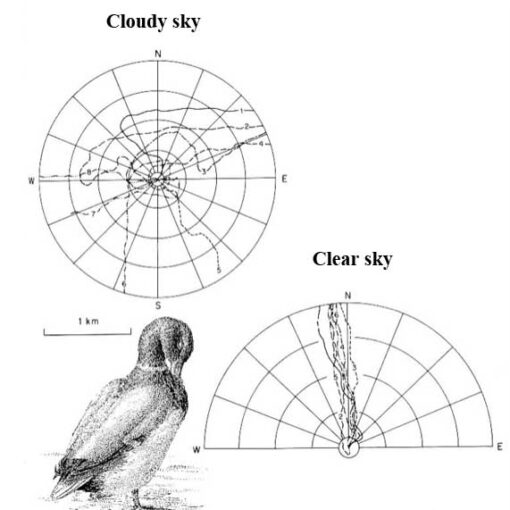



One thought on “The Hoopoe, bird of myth”